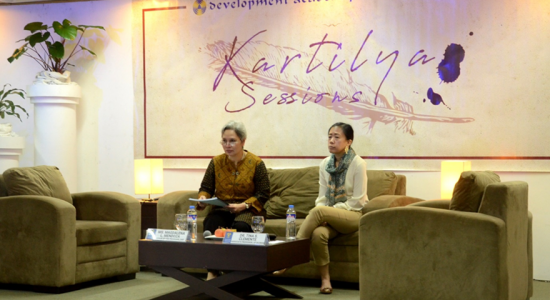
during the Kartilya session on “Measuring Public Sector Productivity.”
University of the Philippines assistant professor Dr. Tina Clemente and Development Academy of the Philippines Senior Vice President for Programs Magdalena Mendoza encouraged government offices to measure productivity in order to track their performance, and also to discover opportunities for improvement as well as document their best practices.
Clemente and Mendoza served as the resource persons during the DAP’s fourth Kartilya Session (Productivity Series) entitled “Measuring Public Sector Productivity” which was held on November 10, 2017 in Pasig City.
Role of public sector productivity
“How the public sector operates actually affects the competitiveness of a country as a whole,” emphasized Mendoza as she explained the encompassing role of public sector productivity (PSP).
The public sector, according to the DAP SVP, has two responsibilities when it comes to productivity enhancement – to improve its own productivity, and then enable all other organizations, both from the government and the private sector, to enhance theirs.
Clemente supported this holistic perspective on productivity by citing examples from the World Economic Forum’s survey on Ease of Doing Business. She stated that the top three problems in doing business in the Philippines are 1) inefficient government bureaucracy, 2) inadequate supply of infrastructure, and 3) corruption.
This she said is an illustration that PSP should not be treated in a vacuum, but rather seen as an aspect that is related to all socio-economic fields in the country.
Measuring productivity
Clemente presented the technical terminologies in productivity measurement such as inputs, outputs, outcomes, ratio indicators and total factor productivity (TFP). She stressed that the most important point in her talk is about TFP, which is the part of growth that cannot be accounted for by inputs. This includes less tangible indicators such as existing systems and services.
Mendoza discussed a case study that measured the productivity of the Bureau of Internal Revenue from year 2000 to 2012 using the Atkinson Review methodology, which may also be applied to other government agencies.
Though measuring public sector productivity is a difficult exercise due to poor data availability and comparability in the Philippines, the two experts has given the Kartilya attendees a way to start measuring productivity in their own agency. This way, little by little, measurement of PSP in the country will be a normative practice in the government.
As DAP President and Chief Executive Officer Elba S. Cruz pointed out in her opening remarks, the measurement of PSP boils down to public accountability. She said that since the expenditure of government comes from the people’s taxes, “taxpayers are naturally interested in how the government uses the proceeds from their tax payments.”




